Report on Joint Research Findings
Fiscal 2021
Principal Research
1. A Study on the Collection of the Autographed Manuscripts of Minoru Betsuyaku
Selected Research
2. Research on Musicians and Musical Bands through Kurihara’s Musical Score Collection: Music for Stage and Cinema during the Early Showa Era
3. A Basic Research on Silent Film Screenings Using Promotional Movie Materials
4. A Comprehensive Study of Actor Picture Books
5. A Basic Research on Tokiwazu-bushi Woodblock Printings Formerly Owned by Sakagawaya
Principal Research 1
A Study on the Collection of the Autographed Manuscripts of Minoru Betsuyaku
Principal Researcher
Itsuki Umeyama (Associate Professor, Department of Performing Arts, Faculty of Literature, Arts and Cultural Studies, Kindai University)
Collaborative Researchers
Minako Okamuro (Professor, Faculty of Letters, Arts, and Sciences, Waseda University, and Director, Theatre Museum, Waseda University)
Ryuki Goto (Assistant Professor, Theatre Museum, Waseda University)
Research Objectives
This study verifies the writing style of Minoru Betsuyaku’s plays through the survey of the Collection of the Autographed Manuscripts of Minoru Betsuyaku, donated in 2019, and materials related to his works. So far, the research on these works at the Collaborative Research Center has focused on materials that have yet to be examined, as the center strives to better understand the entire picture surrounding the large amount of materials that have been donated. This has made it clear that these materials include important documents related to creative writing notebooks believed to be from Betsuyaku’s 20s and his early works from the 1960s. This year, we focused on examining materials thought to be important to provide a glimpse of these early creative activities.
Summary of Research
Based on the survey results, we held the Special Spring Exhibition 2021 Making of Minoru Betsuyaku: From His Unpublished First Play to the Soyosoyo Tribe from June 3 to August 6, 2021. Along with research results, a panel presentation titled “The World of Minoru Betsuyaku as Seen from New Materials” was held online at the 15th annual conference of the Association for Studies of Culture and Representation on July 4. Curator Yuko Mukai (research collaborator) was responsible for the composition of the exhibition and introduced the audience to drafts of the phantom maiden drama Hokuro Soseji [64256], early representative work The Elephant [64257], and Akaitsuki, which is believed to be the original draft of The Elephant. In addition, other important materials such as maps that can be used to trace the process involved until the completion of the work, which Betsuyaku himself created when working on the Soyo-Soyo Zoku series, were exhibited.
In the conference presentation, Itsuki Umeyama shed light on Betsuyaku’s childhood compositions, creative writing notebooks from his early days and Hokuro Soseji, and explored the roots of Chinmoku (silence). Ryuki Goro compared the script of the animated film and radio drama based on Kenji Miyazawa’s Night on the Milky Way Train, which seems to have been greatly influenced Betsuyaku’s work. Moreover, Betsuyaku’s published scripts and plays indicated the impact of Kenji Miyazawa on his ideas. Minako Okamuro explored how the concept of Soyo-Soyo Zoku was established using the awareness of hinkon (poverty) and kiga (hunger) as glimpsed in Betsuyaku’s diaries and using the creative writing notebooks as clues. Okamuro considered these to be the path that led to plays known as Shoushiminmono (works depicting the lower middle class), such as Abukutatta Niitatta (Bubbling and Boiling).
Important keywords for understanding the basis of Betsuyaku’s works, such as chinmoku (silence), hinkon (poverty), zou-o (hatred), and jiko-gisei (self-sacrifice), emerged from the research, as it became clear that his early works foreshadowed these themes. Moreover,the research showed that his interest in non-theatrical literature such as the works of Kenji Miyazawa and Shichiro Fukazawa had a considerable influence on the formation of Betsuyaku’s literary style.
In future research, we will seek to analyze literary works dating back to the 1970s using keywords such as chinmoku (silence), hinkon (poverty), zou-o (hatred), and jiko-gisei (self-sacrifice) as clues and subsequently sort through changes in Betsuyaku’s style. We would also like to clarify how interest in the literary works of Miyazawa, Fukazawa, and others, as well as nursery rhymes and old songs, have been reflected in his literary works.
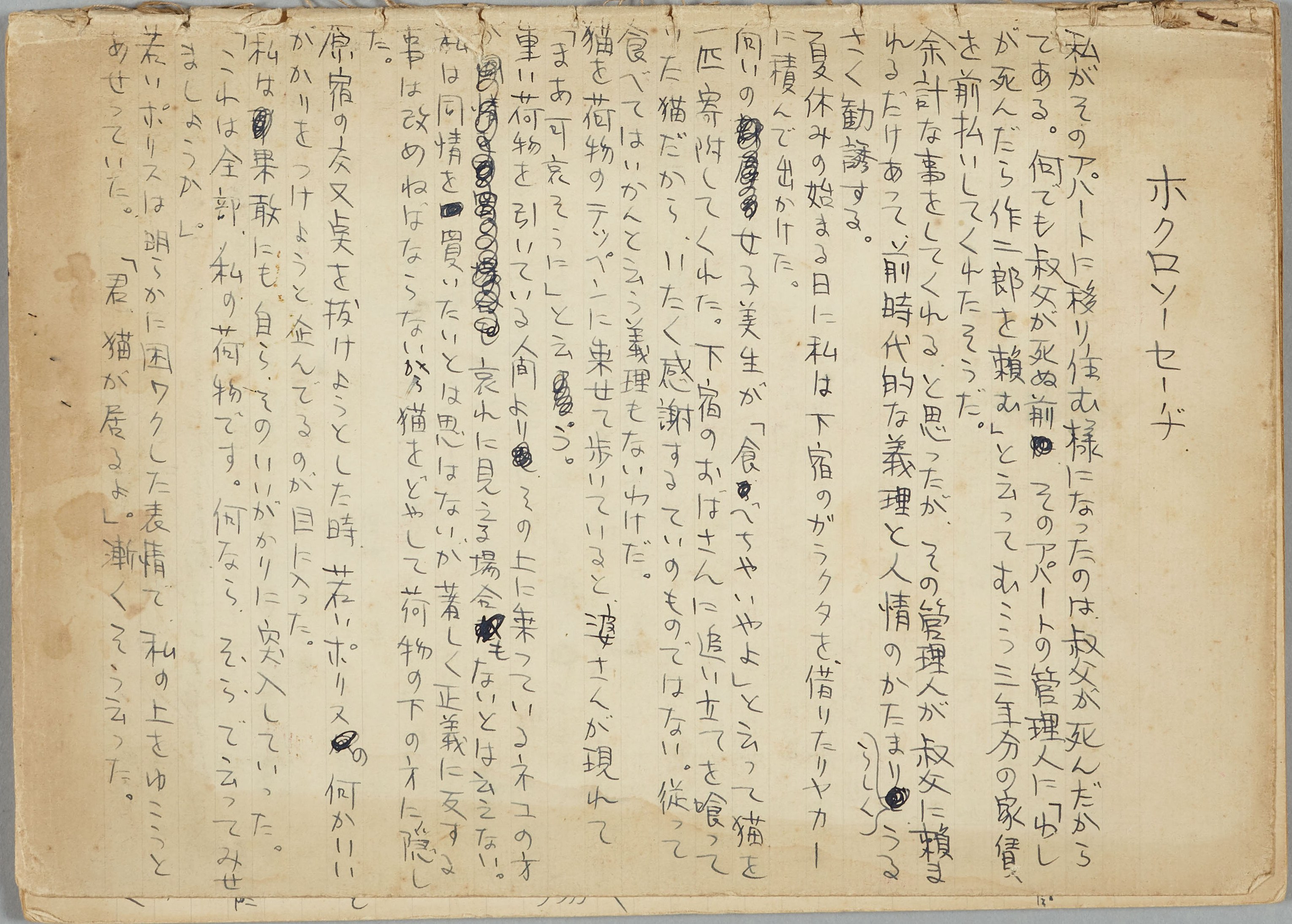
Hokuro Soseji manuscript[64256]
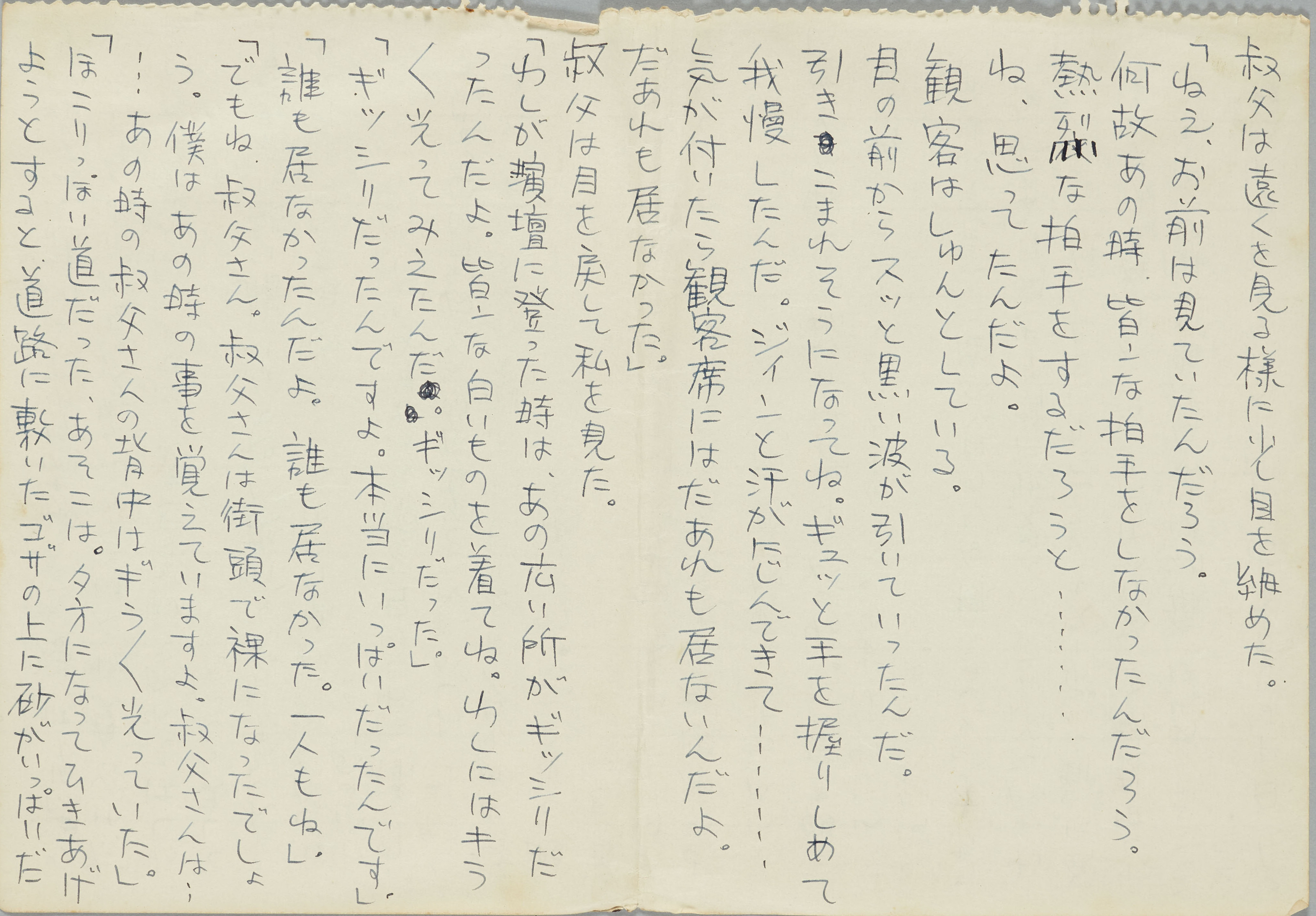
An autographed manuscript believed to be for The Elephant[64257]
Selected Research 2
Research on Musicians and Musical Bands through Kurihara’s Musical Score Collection: Music for Stage and Cinema during the Early Showa Era
Principal Researcher
Masaaki Nakano (Affiliated Lecturer, School of Arts and Letters, Meiji University)
Collaborative Researchers
Fumito Shirai (Associate Professor, School of World Liberal Arts, Nagoya University of Foreign Studies)
Yohei Yamakami (Project Lecturer, Komaba Organization for Educational Excellence, The University of Tokyo)
Masato Mori (Independent Researcher)
Hiroyuki Kojima (DoctoralProgram, Graduate School of Arts and Sciences, The University of Tokyo)
Research Objectives
Shigekazu Kurihara (1897–1983) was a musician active in the Enoken Orchestra and Shochiku Kinema’s performance department, as well as the P.C.L. (Photo Chemical Laboratory) Film Studio. This research investigates and analyzes music scores formerly belonging to Shigekazu Kurihara and the Enoken Orchestra. Based on the results of an examination of musical score materials, we combined written materials with surveys of collections of related sheet music from the same period in this study. Through empirical research on the actual activities of Kenichi Enomoto (1904–1970) and other contemporaneous musicians and orchestras with whom Kurihara worked, we aimed to clarify the process by which a wide range of contemporary theaters, music, and films were produced.
Summary of Research
〇 Survey and analysis of the sheet music
Utilizing digitized materials and under the direction of Kojima, we proceeded to catalog, about 1,100 materials—a mix of imported music and manuscripts from Kurihara’s collection. We included in the catalog not only basic information such as song title, composer/arranger, and year of publication, but also the status of the materials, such as the presence/absence of ownership stamps or handwritten annotations. We thus laid the foundation for more detailed analysis and verification of this material.
〇 Comparative examination of related musical score materials of the same period
We conducted a baseline examination of older materials belonging to Masao Shinohara (Shitamachi Museum). Shinohara was a musician who played an active role in the early days of Japanese operas such as the Asakusa Opera. The Kurihara collection contains several musical scores thought to have been owned by Shinohara, and comparative examination with the Shinohara materials has important significance to clarify the history of the Kurihara collection. Moreover, comparative examinations with the Hirano Collection— a collection of scores that accompanied silent movies held by the Theatre Museum—and collections of contemporary sheet music scattered throughout the United States and Europe are expected to serve as steppingstones in positioning Kurihara’s activities in a broader context.
〇Creation of a brochure highlighting accomplishments
Focusing on the results of “Shigekazu Kurihara and Musicians of the Same Era,” a symposium held at the end of 2020, we created a brochure summarizing the intermediate results of joint research carried out since 2018. Research results after analyzing materials from Kurihara’s collection, such as analysis of stamps which testify ownership (Yamakami), relationships with silent film accompaniments (Kotaro Shibata, Research Collaborator), the process of creating music for movies (Kojima), and the feasibility of restoring theatrical productions (Shirai) are summarized in this brochure. Also included are articles that analyze a wide range of the activities of Kurihara and Enomoto, such as an overview of Kurihara’s activities related to records and film music (Mori), an investigation of Enomoto-related stage photographs purchased by the team (Nakano), and an analysis of the movie Son Goku (Makiko Kamiya, Research Collaborator). We also included an interview with music critic Masahisa Segawa, who previously owned the Kurihara collection, providing valuable testimony about the musicians surrounding Kurihara.
Based on this year’s results, we would like to see in the future a more focused approach to Enomoto’s Japanese translations of songs, analysis of Kurihara’s both early and later activities, and further attempts at systematic restoration of musical performances.
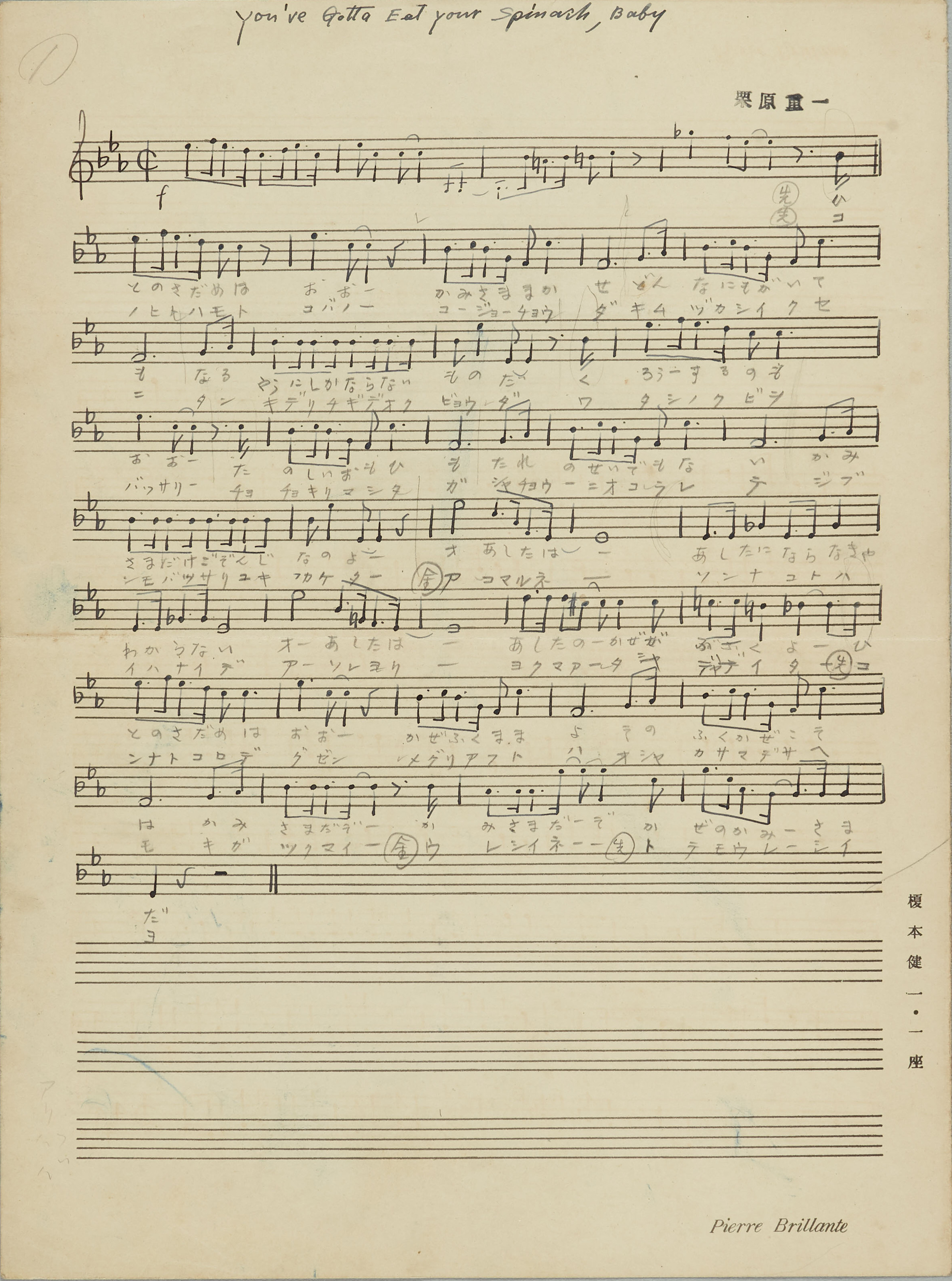
Handwritten Score《 You’ve Gotta Eat Your Spinach, Baby》[47624]
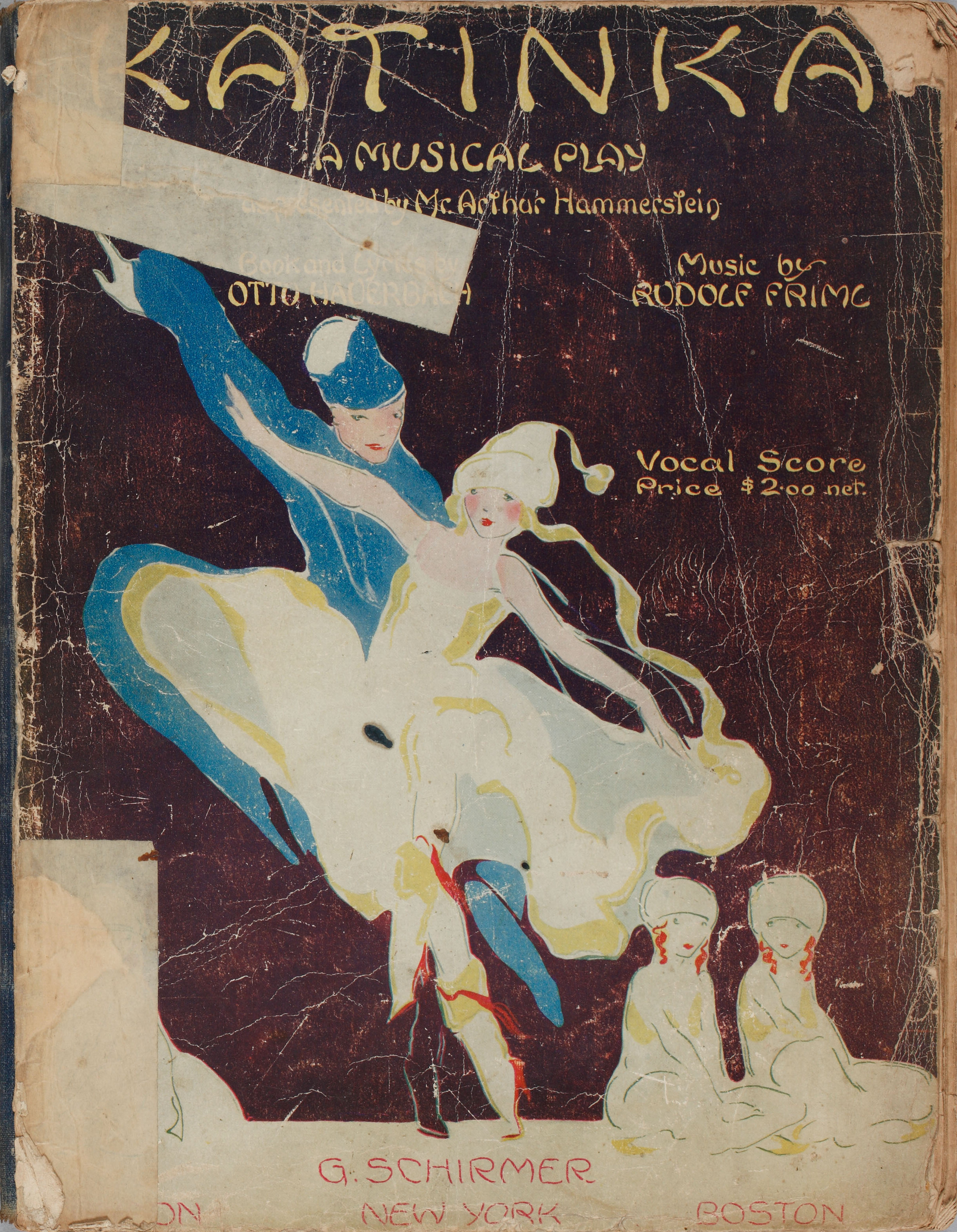
Vocal Score《KATINKA》(Music: Rudolf Friml)[47368]
Selected Research 3
A Basic Research on Silent Film Screenings Using Promotional Movie Materials
Principal Researcher
Hidenori Okada (Chief Curator, National Film Archive of Japan)
Collaborative Researchers
Makiko Kamiya (Part-time Lecturer, Musashino Art University)
Kotaro Shibata (Junior Researcher, Theatre Museum, Waseda University)
Research Objectives
The objective of this research titled “Movie Theaters Flyers from the Taisho to the Early Showa Periods” was to conduct a baseline study on Japanese silent films through examinations of flyers from movie theaters during the Taisho to the early Showa periods and related materials. For our objective, we conducted specific research on the programming, screening, and demonstration forms, benshi (silent film interpreter), and music (accompaniments and intermission musical performances) information provided in the flyers and others. Through these investigations, we aim to clarify an aspect of the movie shows during the silent film era that have yet to be historicized.
Summary of Research
This year, we updated the cataloging of 600 of the approximately 900 flyers belonging to the film genre. Thus, we continued to create a complete catalog version by focusing mainly on flyers issued for “first-runs” in urban areas and on flyers lacking dates (in some cases, only the day of the week was listed). We attempted to identify when these flyers were issued by examining movie theater programs, newspaper advertisements, databases (Japanese Movie Database, Japanese Cinema Database, and IMDb), and other information related to movie releases.
Access to contemporary film materials of that time is essential to investigate silent film performances, but many of these materials are now missing, and only a few public facilities are in possession of those few that remain. Benshi Ichiro Kataoka, who had just published The People Who Brought Soul to the Movies (Kyowakoku, 2020), was invited to hold a study group on October 28 at Theatre Museum, Waseda University. In addition to the study group participation of Principal Researcher Hidenori Okada, collaborative researchers Kotaro Shibata and Makiko Kamiya, and research collaborators Fumito Shirai (online participation; Nagoya University of Foreign Studies), Yoriaki Sazaki (National Film Archive of Japan), and Haruhiko Honchi (a Japanese film historian and well-known collector; National Film Archive of Japan) also attended. The group actively exchanged opinions on the collection and utilization of movie-related materials from the silent movie period, including actual observing the Kataoka collection.
Marking our final year, we also spent this year concentrating our efforts on materials-based restoration screenings of silent film. This attempted to reproduce an example of the entertainment style of the period that emerged from a flyer of Ikebukuro Heiwa-kan (around 1923) included in the “Movie Theaters Flyers from the Taisho to the Early Showa Periods.” The screening project was made possible because the film and benshi-script in question, Goro Masamune Koshiden (Tenkatsu, 1915), was in the collection of the National Film Archive of Japan. In this project, based on the benshi-script, the benshi performance (by Kataoka), with a mainstream style in the 1920s, with the naniwabushi (rōkyoku; storytelling accompanied by a shamisen) performance (by Ichitaro Azumaya) partially inserted. The style of dialogue in this benshi script included the gidayūbush (narrative style in the puppet theatre tradition), but for this project, here it was replaced with naniwabushi. We also aimed to restore the screening format using a Japanese-Western ensemble (conduct and shamisen by Joichi Yuasa, narimono [a musical instrument] by Kisayo Katada, et al.) from a score selected from the Hirano Collection of the Theatre Museum (scores used by the resident musician of a movie theater during the silent movie era). As for the means of showing it to the public, this year we decided to distribute it at the “Aspects of Silent Film Promotion in Movie Promotion Materials,”an online conference scheduled on March 7, 2022, after recording the screening. In addition to presentations on the research results of this project (2020–2021) by Okada, Shibata, Shirai, and Kamiya at the conference, plans are to have Kataoka, who is responsible for providing an explanation on Goro Masamune Koshiden, to give a talk while Ryuichi Kodama (Waseda University) provides commentary.

Image Flyer of Ikebukuro Heiwa-kan, around 1923[012-003]
Selected Research 4
A Comprehensive Study of Actor Picture Books
A Comprehensive Study of Actor Picture Books
Principal Researcher
Hiroyuki Kuwahara (Adjunct Researcher, Theatre Museum, Waseda University)
Collaborative Researchers
Hideyuki Iwata (Emeritus Professor, Faculty of Letters, Atomi University)
Misa Umetada (Associate Professor, Faculty of Core Research, Humanities Division, Ochanomizu University)
Masae Kurahashi (Visiting Researcher, Kinugasa Research Organization, Ritsumeikan University)
Tsugunao Katō (Associate Professor, Tokai University Center for Liberal Arts)
Chie Saitō (Adjunct Researcher, Theatre Museum, Waseda University)
Emi Nakamura (Visiting Researcher, Kinugasa Research Organization, Ritsumeikan University)
Asahi Kuwano (Adjunct Researcher, Theatre Museum, Waseda University)
Research Objectives
Actor picture books are compilations of kabuki actor portraits that also contain features that serve as actor directories. They have been published from the late seventeenth century through modern times, and make it possible to discover information about actors of every era. The purpose of this study is to survey and compile information on actor picture books from each period and use this image data to provide basic material for identifying actors. This study compiles data that has been gathered as the result of successive research based in particular on the actor picture books owned by the Waseda University Theatre Museum, which holds most of the well-known titles. We will then share the results, as well as publish a catalog.
Summary of Research
Since there are other materials besides conventional actor picture books with portraits that can be used as
directories for actors, we updated a basic list of actor books that had been completed just last year, so that now a total of 104 materials are listed. Seventy-five of these are photos of items from the Theatre Museum. We plan on disseminating these research results as an image database.
Although some traditional actor picture books should ideally be reclassified into different categories, such as
dialogues, actor trivia, chronicles, and commentaries, we continue considering all of them as actor picture books because they can also serve as actor directories. Therefore, we made a conscious decision here to note these titles. As these actor picture books contain portraits of low-ranking and child actors as well as sometimes include each actor’s hokku, they serve as invaluable supplements to actor rankings and commentaries with pictures of difficult-to-recognize actors and poetry names.
Among the modern actor picture books included in this database are: Tōsei yakusha sanjū rokkusen 当世俳優
三十六句撰, illustarated by Morikawa Chikashige (1881); Manzai fuku Chimata no nigiwai 萬歳富久 市中の賑ひ,
produced by lithographic printing (1887); actors' paintings by Yoshiiku 芳幾肉筆役者絵 (1901) that were reproduced as illustration for Nishida Kinpa’s serialized essay Haiyū hyakumensō 俳優百面相 in the periodical Kabuki 歌舞伎; Shin nigaoe 新似顔, volumes 1-4 (1915); Kabuki omokagegusa 歌舞伎俤草, illustrated by Matsuda Seifū (1929); Shin mizu ya sora 新水やそら, illustraed by Okamoto Ippei’s picture (1930); and several others. Using this image database, we found pictures of more than 2,700 actors, spanning the 160
years since the Ehon butai ōgi 絵本舞台扇 was published in the mid-Edo period.
Moreover, this study includes discoveries requiring bibliographical attention. Yakusha kowairo zue 役者声色
図画 of 1848 is a re-rendering of Kōka hitsuji hyōban Shibai nenjū kagami 弘化未評判 戯場年中鏡 (1848), while Kowairo gakuya kagami 声色楽屋鏡 of circa 1858 is a revision of an adaptation of Kowairo hayagaten 声色早合点 of 1853, known through a copy of Waseda University Library Collection, 1853. However, there are also completely different works sharing the same title Kowairo hayagaten, published between 1831 and 1833.
In the previous volume of News Letter, we referred to Ehon butai ōgi, which was previously owned by Ishibashi Kanichirō. However, the precise provenance is that the copy was donated to the Theatre Museum by Mr. Ishibashi, who was previously presented with it by the former owner of Kawarasaki Chōjūrō of Zenshinza.
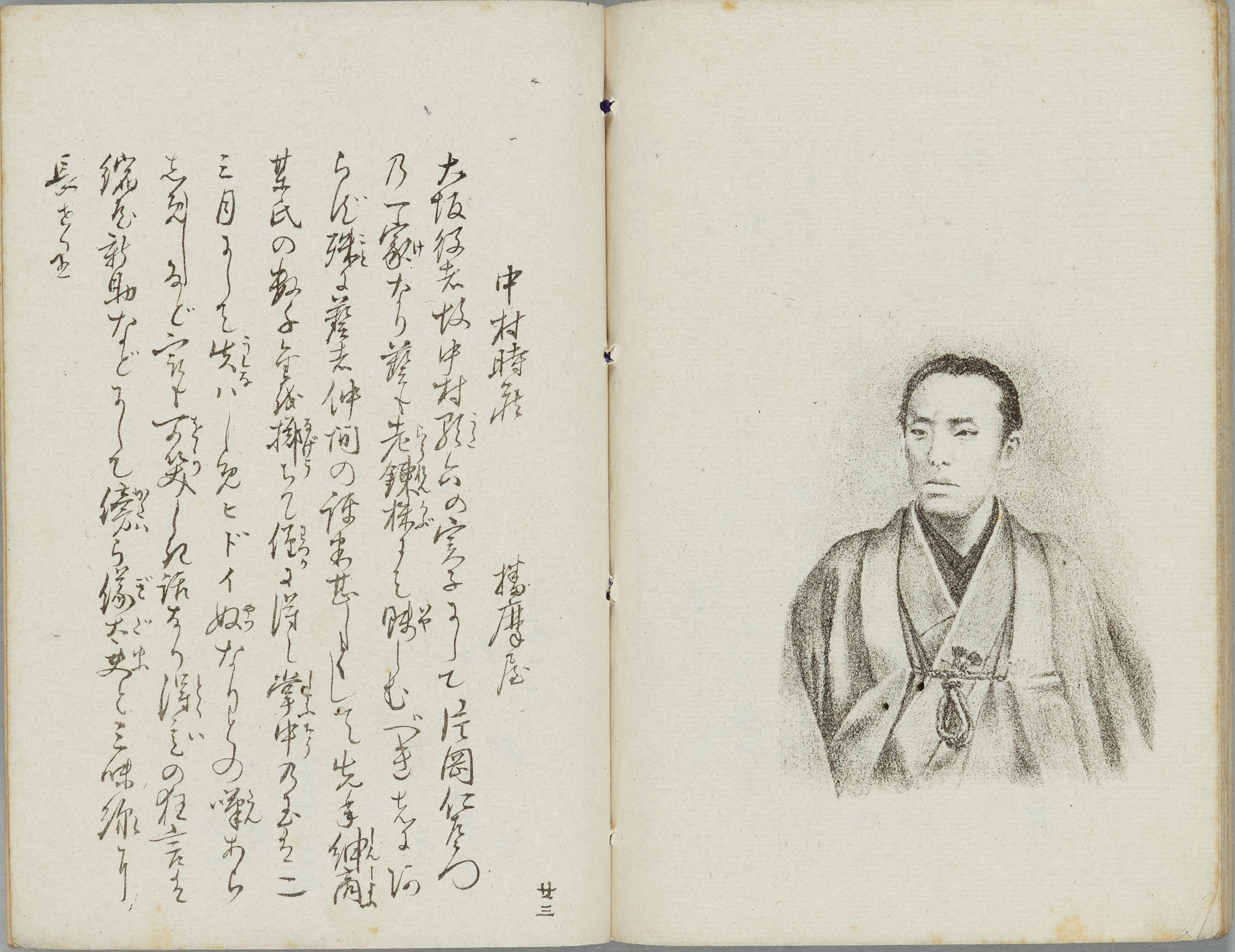
Manzai fuku Chimata no nigiwai, lithographic printing for both text and illustrations[ro03-00125_028]
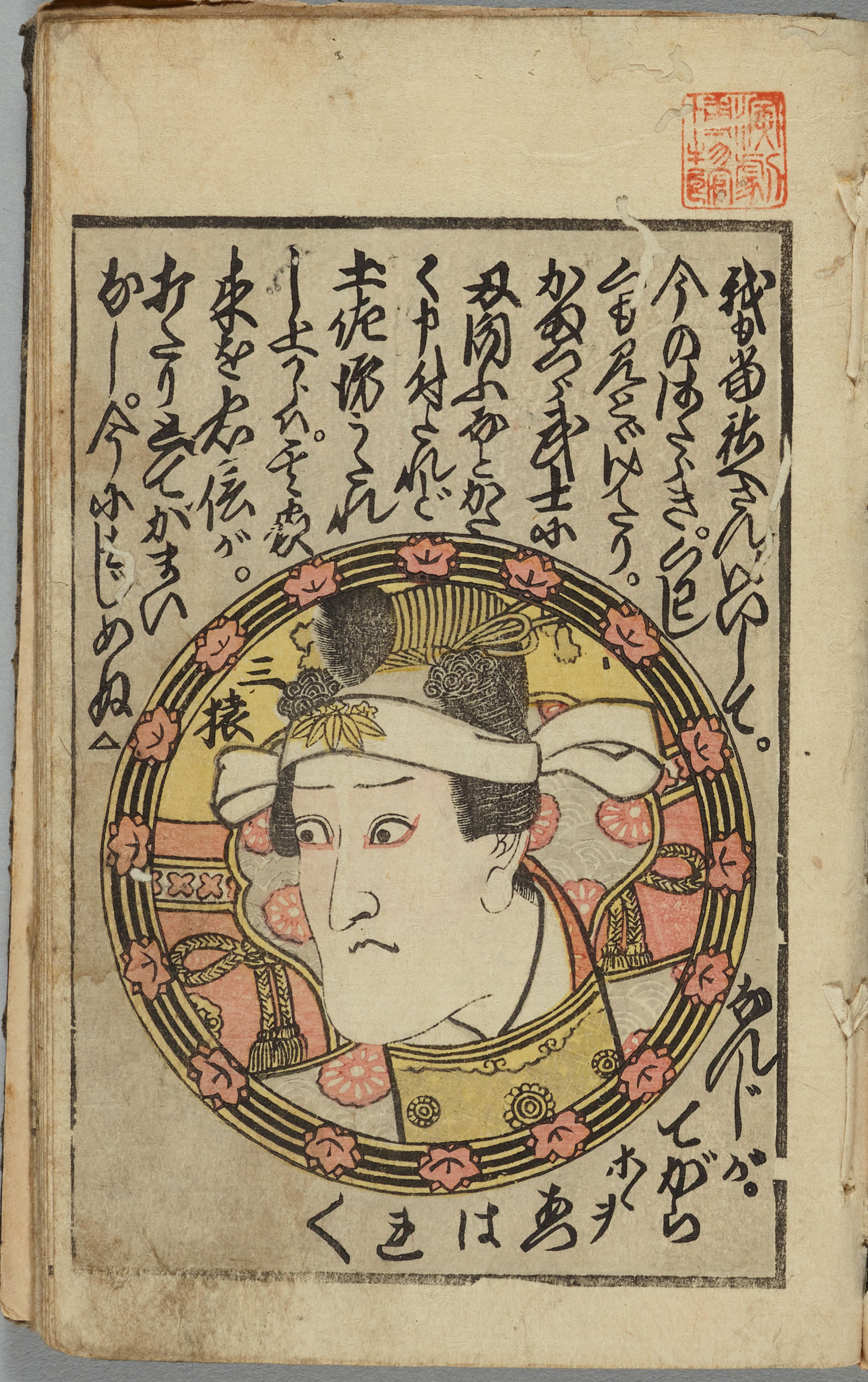
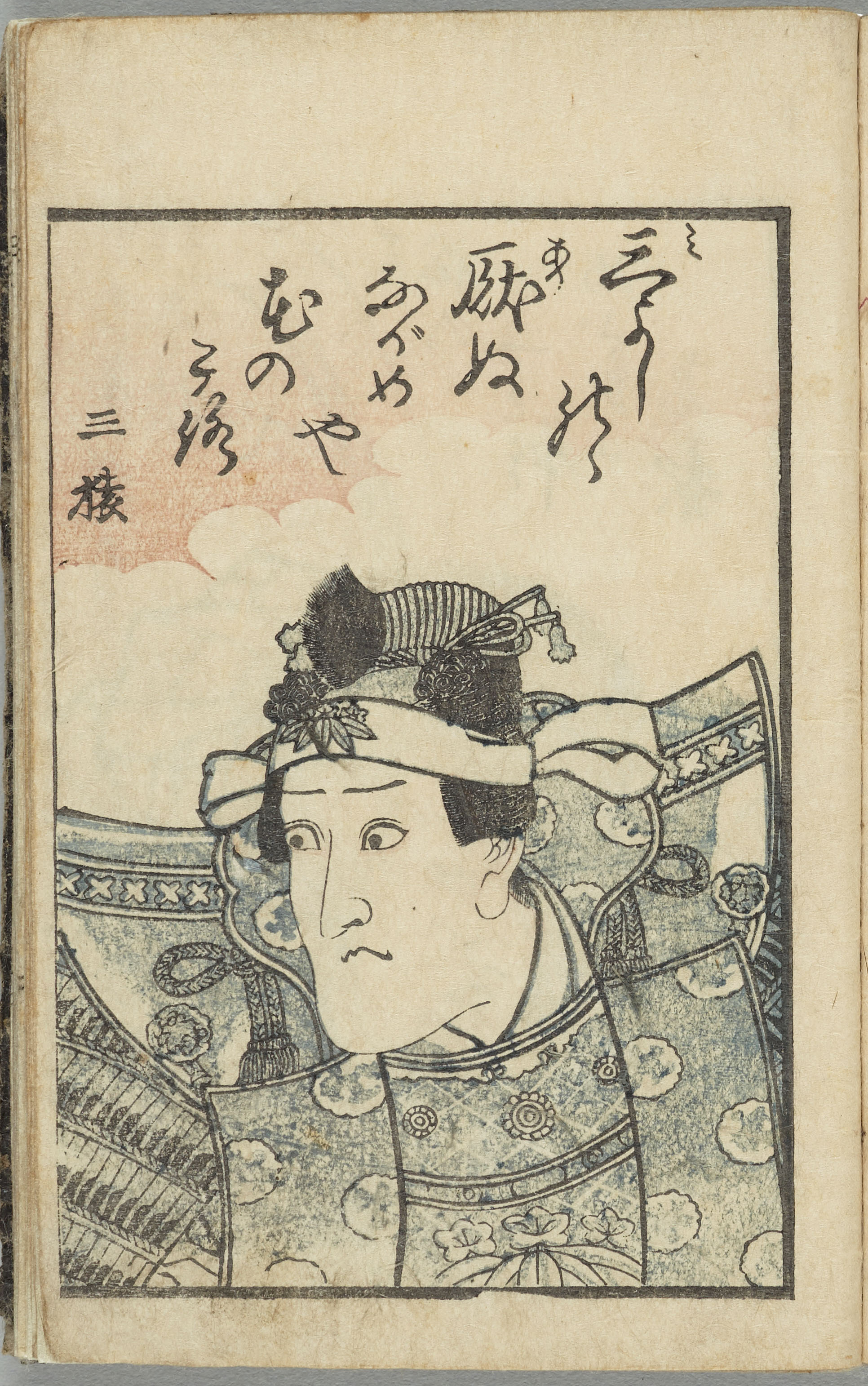
(L) Kowairo gakuya zue opening[ro06-00017_002]
(R) Koka hitsuji hyoban Shibai nenju kagami Ichimura-za, opening[ro11-00051_003]
Selected Research 5
A Basic Research on Tokiwazu-bushi Woodblock Printings Formerly Owned by Sakagawaya
Principal Researcher
Yuuichi Takeuchi (Professor, Research Institute for Japanese Traditional Music, Kyoto City University of Arts)
Collaborative Researchers
Eiichi Suzuki (Adjunct Researcher, Theatre Museum, Waseda University)
Ryou Tsuneoka (Director, Tokiwazu Association)
Satomi Abe (Part-time Lecturer, Musashino Academia Musicae)
Miho Maeshima (Part-time Lecturer, Tokyo University of the Arts)
Gyoo Shigefuji (Part-time Lecturer, Edogawa University)
Shiho Konishi (Collaborative Researcher, Kyoto City University of Arts)
Research Objectives
Sakagawa-ya received woodblock prints from Iga-ya, a publisher of original jōruri narratives, in 1860, during the last days of the Tokugawa shogunate, with new editions published until the end of the Showa period. By 1987, these were used to create practice books for jōruri and nagauta. Sakagawa-ya, a woodblock printer during the Edo period, is thought to be one of a handful of publishers who continued to use woodblocks. Even today, there is much Tokiwazu-bushi folklore about the experience of going to Sakagawa-ya to have a practice book made. This research targets existing woodblocks owned by publishers, of which there are about 800, with the objective of providing a full accounting of woodblock groups by creating and publishing a catalog. Through this public appeal for research, in 2020, we sought to create a simple catalog of each play/act title, while in 2021, we aimed for a detailed list of each woodblock.
Summary of Research
Moving from 2020 to 2021, we proceeded with a bibliographic survey of the actual woodblocks, collating blocks and existing photos/images with past survey data. Based on these, we created a detailed catalog (organized by each major woodblock surface) with additional photography centering on unphotographed surfaces such as the back and sides. Moreover, to consider the publishing system more deeply for jōruri practice books from a woodblock perspective, a
research meeting was held where two outside specialists in the field shared their knowledge. At this meeting, we exchanged opinions on points to consider when taking additional photographs of woodblocks, and on the conservation of these blocks.
Major features of the woodblocks and pertinent future issues as considered by a series of research studies beginning in 2020 are as follows:
1. Woodblocks as presented in the text are of the Nichōgake variety, with carvings on the front and back of single blocks. There are no Yonchōgake blocks, which were the most prevalent in book publishing.
2. Colophon and play/act title woodblocks were of different sizes and appearance than text woodblocks. These were stored separately from text blocks, typically in separate boxes for colophon blocks and play/act title blocks. (It is presumed that this storage method was largely kept in place when the business changed hands.) This is thought to indicate that printing of the text and the play/act title and colophon was not always performed at the same time.
3. Point (2) is probably related to the custom of customizing multiple play/act titles according to the customers’ request, binding them, and then readying them for delivery. Many existing bound volumes (books containing multiple play/act titles) do not have covers or colophons for individual play/act titles. Demand for providing customers with cheaper bound books by eliminating the trouble of attaching play/ act titles and colophons may have increased at some
point.
4. Abbreviations on the sides and edges of the play/ act title and colophon woodblocks support the arguments made in (2). It is thought these were written to indicate matches with separately positioned text woodblocks. The play/act title and colophon woodblocks will be formally cataloged beginning in 2022.
5. There are signs of insect damage on several woodblocks. Thus, there is an urgent need for conservation measures, which were approved prior to donation (around 1995) to the Theatre Museum, to prevent recurrence.
6. In addition to woodblocks that are the subject of this study, we confirmed the storage status of prebound Syûsatsu (printed material created by impressing a sheet of paper on an inked woodblock), which were stored at the same time as the woodblocks. Since these are rare, they should be sorted and classified sometime in the future.
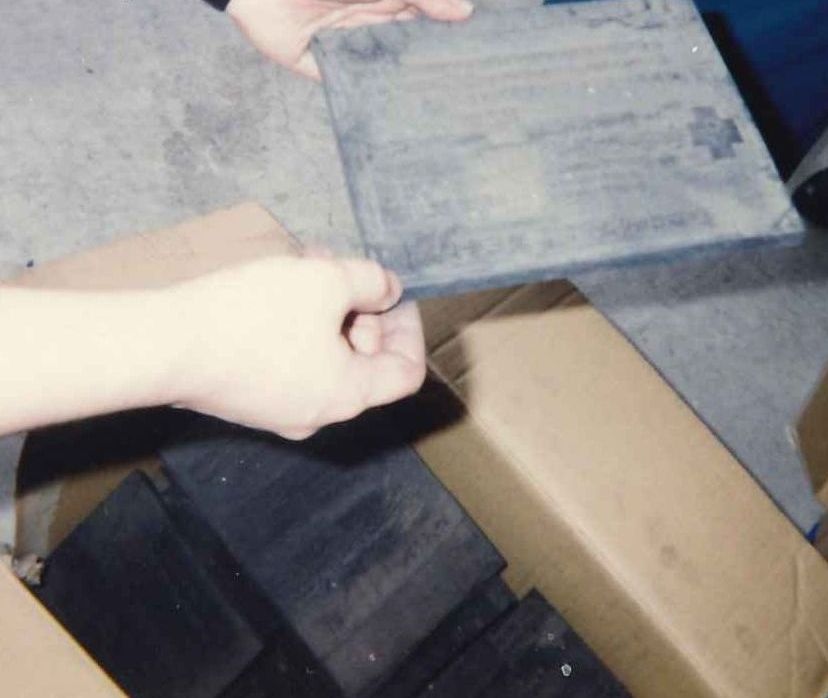
Taken on October 5, 1994 at the printing company warehouse (Iwatsuki City) of an acquaintance of Mr. Sakagawa. Woodblocks, printed materials, etc., were stored in about 40 cardboard boxes. At that time, the Kunitachi College of Music Research Institute where Suzuki and Takeuchi worked as researchers conducted a preliminary survey of the woodblocks. Many were covered with dust and had turned whitish, making it difficult to remove the dust and dirt. The woodblock shown here is[29888-794](32-38).